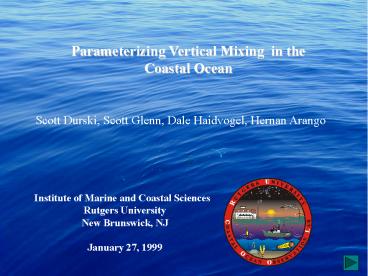Parameterizing Vertical Mixing in the Coastal Ocean - PowerPoint PPT Presentation
Title:
Parameterizing Vertical Mixing in the Coastal Ocean
Description:
depth ranges from 6m at the coast to 40m offshore. Grid resolution varies from 500m at the coast to 4km offshore. ... upwelling at the coast. Diffusivity ... – PowerPoint PPT presentation
Number of Views:219
Avg rating:3.0/5.0
Title: Parameterizing Vertical Mixing in the Coastal Ocean
1
Parameterizing Vertical Mixing in the Coastal
Ocean
Scott Durski, Scott Glenn, Dale Haidvogel, Hernan
Arango
Institute of Marine and Coastal Sciences
Rutgers University New Brunswick, NJ January
27, 1999
2
Vertical Mixing Processes
Model Parameterizations
2nd and higher order closure schemes -
Mellor-Yamada, Gaspar, Stull.
Boundary layer mixing
K profile parameterizations (1st order) - Troen
and Mahrt, Large, McWilliams and Doney.
Mixed layer models - Price et al. ,Kraus and
Turner.
Langmuir circulation
Surface wave breaking
Interior shear driven processes
Gradient Richardson number based schemes -
Pacanowski-Philander, Large et. al(interior
scheme), Kantha and Clayson.
2nd and higher order closure schemes -
Mellor-Yamada, Gaspar, Stull.
Background mixing constant - Large et al.
Internal wave breaking
Proportional to N-1 - Gargett and Holloway..
Double diffusive processes
Density ratio base schemes - Large et al.
3
Boundary layer mixing
Interior mixing
Mixing parameterized as a function of boundary
layer depth, turbulent velocity scale and a
dimensionless shape function.
Shear generated mixing
Based on gradient Richardson Number
Boundary layer depth
Based on bulk Richardson number.
Internal wave mixing
Constant background mixing value from open
ocean thermocline observations.
Turbulent velocity scale
From atmospheric surface boundary layer
similarity theory
Double diffusive mixing
Based on laboratory measurements, based on
density ratio.
Shape function
Third order polynomial with coefficients
determined from boundary conditions at surface
and ocean interior.
4
Modifications to the K-profile Parameterization
for coastal ocean application.
Addition of a bottom boundary layer
parameterization
1) Matching with log layer similarity theory
where surface boundary layer extends to the
bottom..
3) Add a K-profile parameterization for the
bottom boundary layer modeled after SBL
approximation.
2) Apply matching rules when surface and bottom
boundary layers overlap.
Kv kuz
Change in internal wave mixing parameterization
for interior
Replace constant value with the buoyancy
frequency dependent formulation of Gargett and
Holloway
Kvi 1.0x10e-7 N-1
5
2-Dimensional Model Setup
Circulation model
- S-coordinate Rutgers University Model (SCRUM).
Idealized 2-dimensional domain
21.5
- 75 km horizontal extent.
- depth ranges from 6m at the coast to 40m
offshore. - Grid resolution varies from 500m at the coast to
4km offshore. - 50 sigma coordinate vertical levels.
- open boundary conditions applied at offshore
boundary.
20.6
19.6
Initialization
18.7
- horizontally uniform stratification.
- stratification ranging from 1017.8 kg/m3 to
1021.5 kg/m3 .
17.8
Forcing
- 4 days of uniform 0.28 dyne along-shore
upwelling favorable wind stress.
6
Basic Model Response
- Advectively dominated upwelling process.
- Formation of an alongshore jet reaching a
magnitude of 50 cm/s
- Development of surface and bottom boundary layers
- Vertical mixing overcomes upwelling in the
nearshore region before sub-pycnocline water
reaches the coast
7
Model-Model Comparison
The basic response with the two schemes is quite
similar but ....
- More intermediate density water is trapped at
the coast with the Mellor-Yamada scheme.
- The surface jet is approximately 10 cm/s weaker
with the Mellor-Yamada scheme.
Across-shore velocity
Density
Along-shore velocity
LMD
M-Y
8
The development of the upwelling front
1) The Mellor-Yamada parameterization entrains
more water into the bottom boundary layer as the
pycnocline advects shoreward causing the
isopycnals of the bottom front to broaden
2)As a consequence of this weaker stratification
occurs sooner in the near shore region with the
Mellor - Yamada scheme.
3) Vertical mixing breaks down this weaker
stratification forming a surface-to--bottom
boundary layer earlier. This prevents further
upwelling at the coast.
Diffusivity
LMD
M-Y
9
What causes the Mellor-Yamada scheme to entrain
more?
Diffusivity profiles
1) The gradient in diffusivity coefficient at the
edge of the pycnocline tends to be greater with
the LMD parameterization.
2) The higher stratification formed by the
compression of isopycnals, creates an
increasingly intense barrier to vertical mixing
3) Mixing at the base of the boundary layer in
open ocean settings is likely to be characterized
by significantly weaker gradients in diffusivity
and density.
10
An alternate formulation for shear generated
mixing
1) The Pacanowski and Philander parameterization
estimates a more gradual variation of diffusivity
with gradient Richardson number between Ri0.15
and 0.6.
Interior shear mixing formulations
LMD
PP
K
11
Comparison of original LMD shear mixing scheme
with modified P-P interior.
Using the Pacanowski and Philander shear mixing
term for the interior produces frontal intensity
and near shore densty structure more similar to
the Mellor - Yamada scheme.
Original LMD
LMD w/PP interior
12
The development of the upwelling front
Diffusivity
LMD w/PP interior
Original LMD
13
Which aspect of PP makes the difference?
14
Summary

